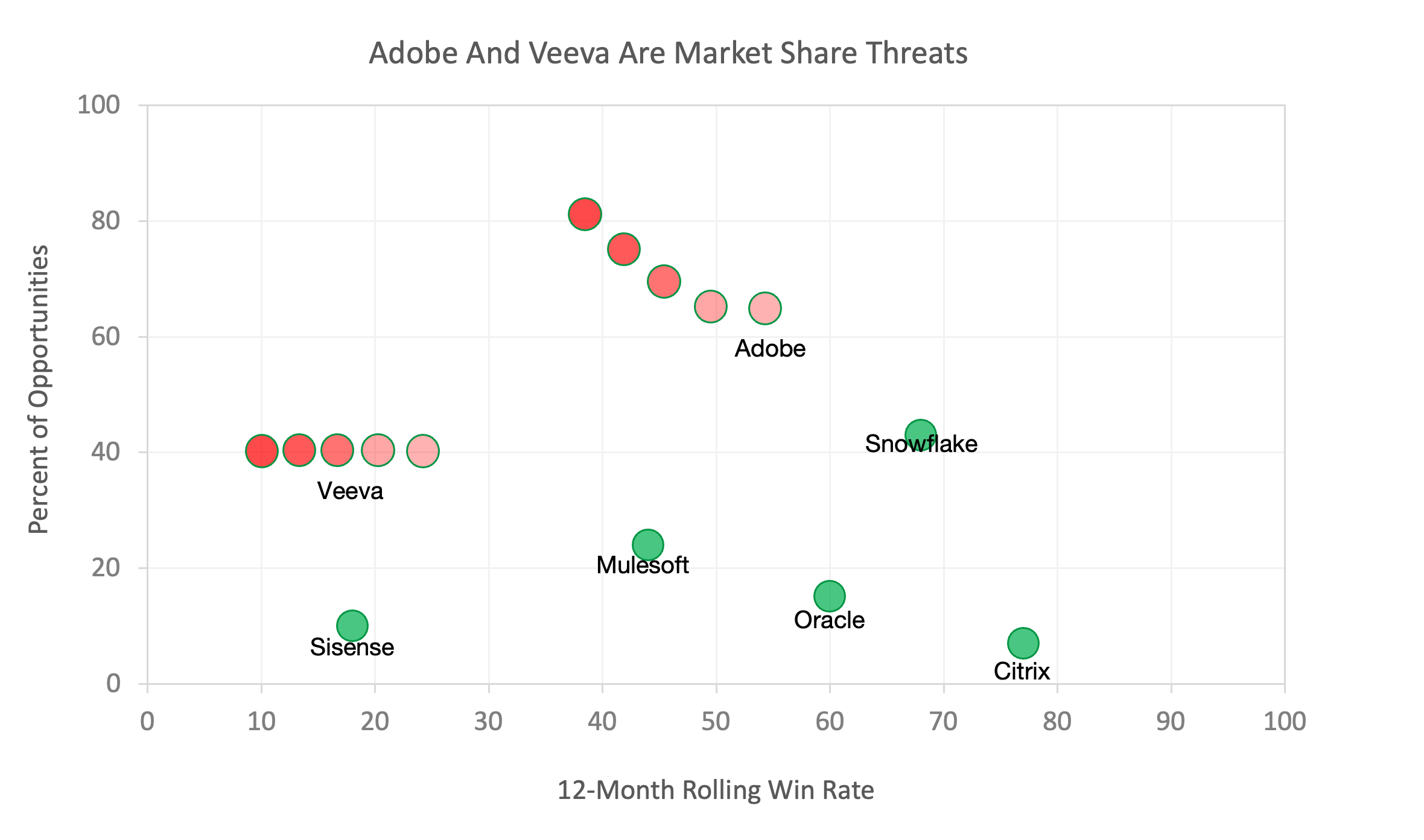We have many excellent tools for gathering and analyzing competitive intelligence. Klue and Crayon make it pretty easy to collect data on our competitors’ changing products and GTM. But there’s something missing.
How is all this activity affecting our business?
New products are introduced. Positioning and messaging are updated. We make changes. Our competitors make changes.
When the net result of all these changes is that a competitor is winning more deals, look out.
Because a competitor that’s increasingly winning against you will look for ways to get into more of your deals.
The risk is real. I’m familiar with the details of one B2B software vendor’s decline after Google’s purchase of a small competitor. This company’s market share has declined to roughly 5% from >30% over the past five years.
Time is of the essence in this scenario.
With the early warning a win/loss survey can provide, there’s time to prepare a defense that reduces the market share loss.
The CRM’s Unfulfilled Promise
This may seem like a problem the CRM can solve. After all, Salesforce can be configured to record the competitors in each opportunity, and validation rules can be used to prevent saving an update to the sales opportunity until the rep has added this key information.
Unfortunately, this is a promise unfulfilled by the CRM. It’s not the technology’s fault. It’s just that neither buyers or sellers are motivated to provide accurate data to your CRM. Buyers won’t tell your sellers the whole truth in a high stakes sales context. And, even if they did, sellers aren’t incentivized to record it consistently or accurately.
I’ve cross-checked the data in a client’s CRM against data collected through buyer interviews. When it came to correctly identifying the primary competitor for won deals, sales reps got it right only 25% of the time. Surprisingly, they did better on lost deals. Lost deals were correct 67% of the time, but that still leaves 33% of the time when the competitor fields in the CRM were incorrect.
So what should you do?
Your CRM’s competitor reporting is leaving you vulnerable to a sneak attack. Up to 75% of the competitor data in the CRM is inaccurate, if my cross-check is representative.
Survey Buyers To Acquire Data About Opportunity Competitors Outside The Sales Cycle
We’ve found that a win/loss survey is an effective way to collect competitor data directly from buyers outside the sales cycle.
This is a request for five minutes of feedback. I mean five minutes literally; we track completion time.
We send the survey request as soon as practicable after the opportunity has closed.
Response rates are high. For complex sales, we get survey responses from up to 90% of wins and roughly 50% of late stage losses.
A survey is highly efficient, making it financially feasible to gather data from so many buyers.
We use win/loss surveys to continuously track the competitors in our clients’ deals — from consideration set, to short list, to selection — as well as buying experience metrics, decision criteria, and product ratings.
Tracking Trends In Competitive Win Rate and Deal Presence

In the chart above, I’ve plotted a set of key competitors by win rate on the x-axis and deal presence on the y-axis.
In this fictional scenario, we would be concerned about the trends in the Veeva and Adobe data. (Marked with red dots.)
This company’s 12-month average win rate against Veeva was 24% one year ago. But over the past 4 quarters, that win rate has been decreasing. The win rate against Veeva is now just 10%.
Adobe is more concerning, because they’re this company’s most prevalent competitor. The 12-month average win rate against Adobe has dropped below 40%. That’s a decrease of 15 percentage points. And Adobe has been increasingly present in their deals. One year ago, Adobe was shortlisted against them in 60% of opportunities. Now Adobe is on almost 80% of short lists.
This might be just good luck on Adobe’s part. Or they may have set a strategy to increase market share by exploiting our weakness at this moment.
Either way, we need to prepare a defense that will reduce the market share loss.
Defending against a competitor’s attack
To defend against a competitor’s attack, combine win/loss surveys with buyer interviews.
With win/loss surveys, we can spot the overall patterns in selection decisions that are driving wins and losses. We can trend them, and we can segment them by industry vertical, geography, and market segment.
With buyer interviews, we dig in to understand why those patterns exist. What specifically buyers are looking for when they assess vendor capabilities on each criterion. And what exactly they perceived as weak or strong when they assessed us or a competitor.
I’ll cover this further in a follow-up post.
Develop An Early Warning Capability For Competitive Threats
When a competitor realizes their win rate against you is increasing, they’ll want to get into more deals against you. And your revenue and market share are going to suffer, unless you can quickly defend against that attack.
I recommend using a win/loss survey to track the trends in competitive win rates and opportunity competitors. This is an effective and efficient way to get an early warning of threats and opportunities.
And with buyer interviews, you can dig deep to learn what’s driving the increase in losses to a specific competitor.
Rigorous, Tech-Enabled Win/Loss Analysis
Related Posts
Sales Win Loss Analysis: Why Data-Driven Leaders Are Leveling Up
Sales win loss analysis helps leaders make data-driven decisions. What’s working and where can we double-down? What isn’t working, and how do we fix it?
Win/Loss Analysis Reports: 3 Things You’ll Learn
Which aspects of your product offering and buying experience are helping drive sales? And which aspects are hindering sales? This is what enterprise and mid-market software companies often struggle to understand. A good win/loss analysis report will provide the answers to these questions.
Three Reasons Sales Leaders Want Even More Data About Their Buyers
While B2B sales teams are literally swimming in data, it’s not enough. Data-driven sales leaders are using input directly from buyers to find new ways to improve win rate and lead with conviction.




